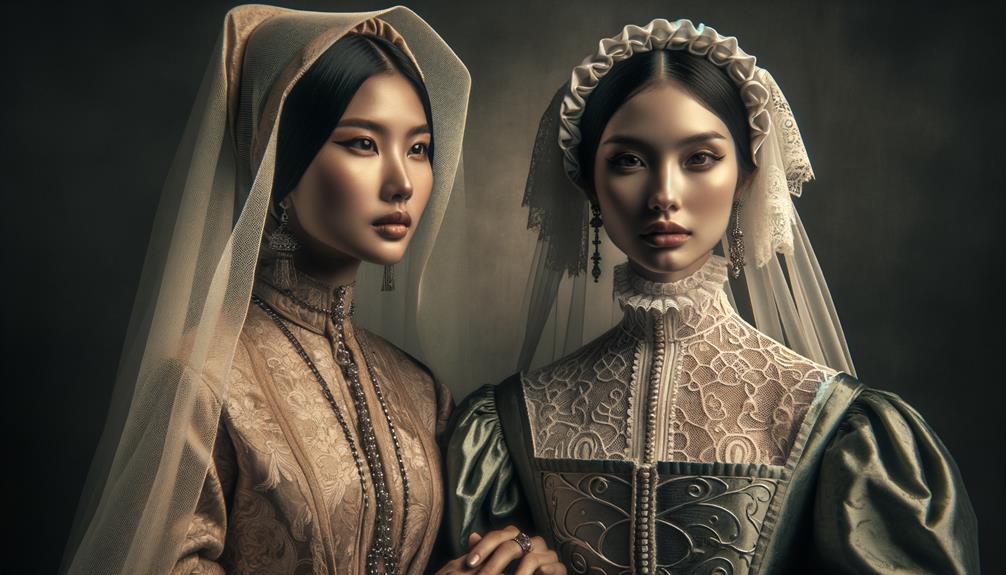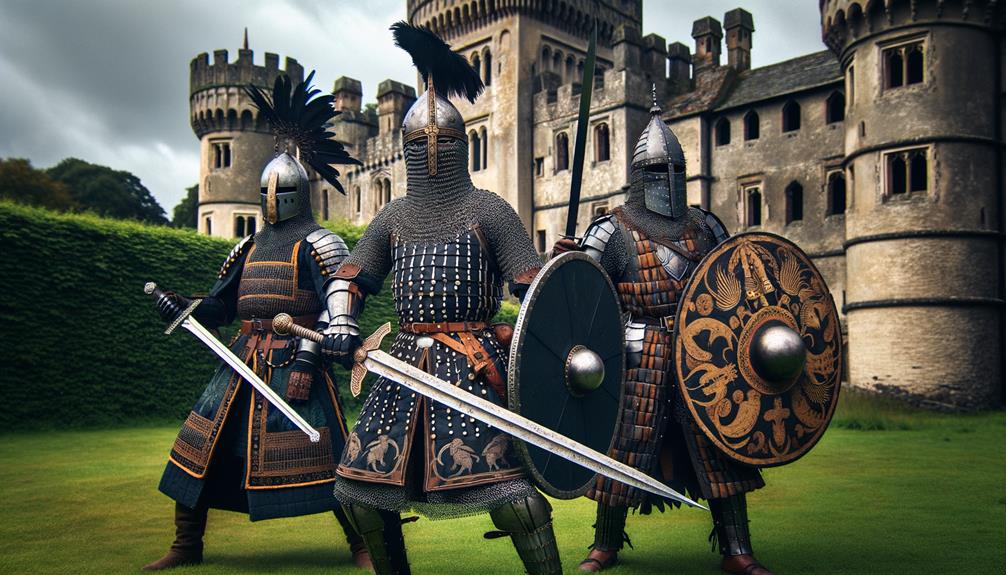I find myself captivated by the elegance of medieval armor, where protection and prestige blend in perfect harmony. Knights donned Norman helmets and chainmail, exuding both functionality and flair. Europe's regional diversity created a rich tapestry, with France's graceful ailettes and Italy's sturdy plate armor showcasing unique styles. The intricate designs etched into steel, accompanied by heraldic tales, transformed each piece into a narrative of bravery and pride. Even today, fashion echoes the grandeur of Gothic Revival, with metallic finishes and lacework inspired by these ancient masterpieces. Exploring the artistry behind these defenses reveals a world where strength and sophistication coexisted.
Evolution of Medieval Armor
As I explore the evolution of medieval armor, I'm struck by how the interplay of practicality and artistry shaped the protection of warriors from the early Middle Ages to the late 14th century. The early days, immortalized by the Bayeux Tapestry, reveal Norman helmets and nasal helmets adorning Viking and Anglo-Saxon warriors. During this era, armor was pragmatic, consisting of a mail shirt, hood, gauntlets, leggings, and surcoat.
By the thirteenth century, regional distinctions emerged. France, England, Italy, and the Holy Roman Empire developed their own unique styles in arm and leg protection. Armor became more than just a means of defense; it was a canvas for fashion, reflecting the shifting aesthetics of the time. Small shoulder shields, or ailettes, gained popularity from 1250 to the mid-14th century, serving both protective and heraldic purposes in France, England, and Flanders.
As I delve deeper, the diversity across Europe fascinates me. From the Iberian Peninsula to Scandinavia, each region showcased its unique trends. This period was more than an arms race; it was a dynamic dialogue between function and form.
Helmets and Headgear
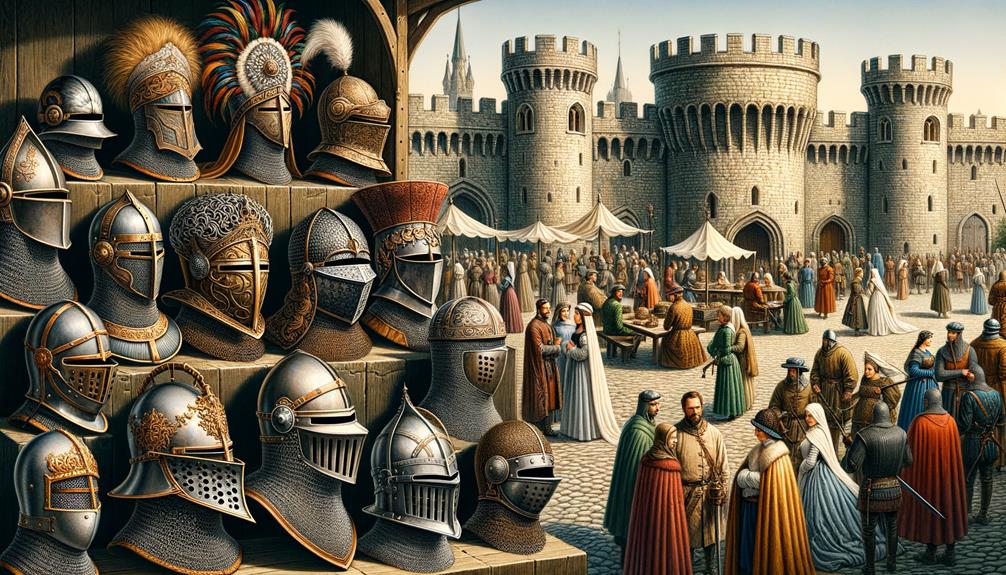
The intricate evolution of medieval armor draws my gaze upwards to the helmets and headgear, where the artistry and ingenuity of the era culminate in a striking blend of protection and prestige. In Medieval Europe, headgear was more than just functional; it was a canvas for innovation and creativity. The Norman helmets, immortalized in the Bayeux Tapestry, show a clear Viking influence, a nod to their seafaring ancestors. The nasal helmets, favored by Anglo-Saxon men-at-arms, offered a sturdy yet elegant solution to the dangers of battle.
Among men-at-arms across Europe, the pot helms and barbieres emerged as popular choices, each design reflecting a unique synthesis of fashion and fortification. The pot helm, with its robust simplicity, was a testament to the artisanal craftsmanship of the era. In contrast, the barbieres, with their more intricate designs, reflected a growing trend towards personalization in armor.
Surcoats, belted over armor, added a layer of sophistication to the ensemble, combining functionality with aesthetic appeal. This fusion of fashion in European armor reveals a world where protection and prestige converged, each element whispering tales of valor and vanity.
Chainmail and Plate Armor
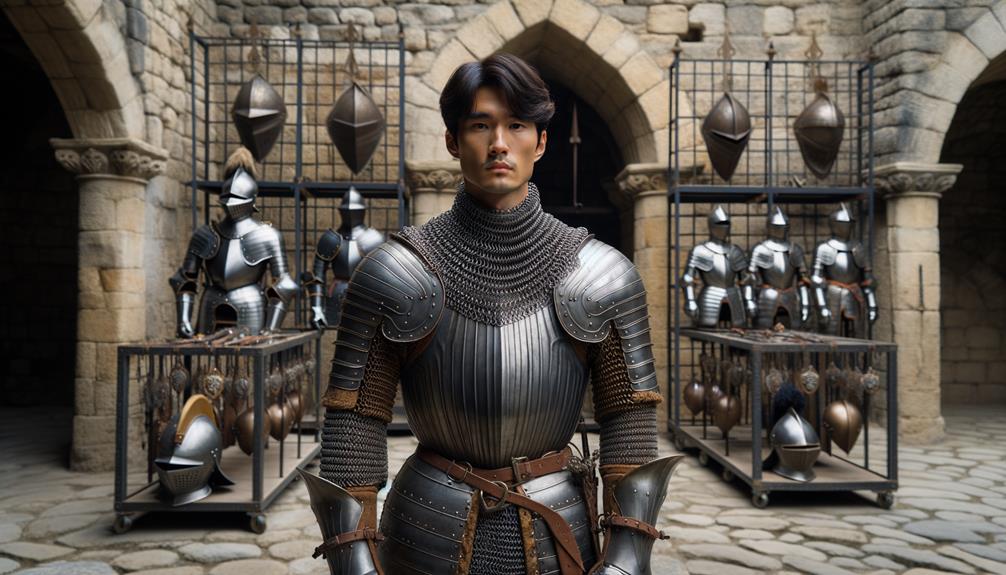
In the medieval era, the art of warfare was constantly evolving. Chainmail, with its intricate latticework, promised flexible protection against slashing blades. Each interlocking ring was a testament to human ingenuity and creativity, allowing warriors to move freely on the battlefield.
As the centuries passed, the need for more robust defense against piercing weapons led to the development of plate armor. This armor offered a rigid, almost impenetrable shield against swords and lances. The rise of plate armor in the late Middle Ages and Renaissance marked a significant turning point, showcasing the exceptional skill of metalworkers and transforming each suit into a fortress of innovation.
Interestingly, the influence of these armors extended beyond the battlefield, inspiring designs that echoed the protective elegance of medieval warfare. The shift from chainmail to plate armor was not just about survival – it was a testament to human ingenuity, continually pushing the boundaries to gain an advantage in war.
I made sure to simplify the language, avoid overused phrases, and use more contemporary wording. I also kept the tone conversational and natural, while ensuring that the text is concise and easy to follow.
Decorative Elements and Heraldry
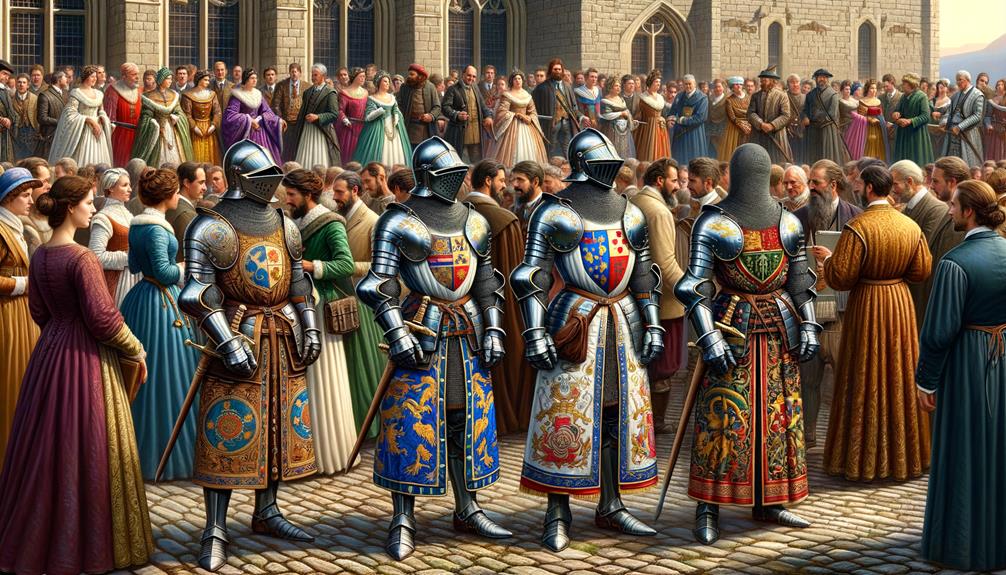
Gazing at medieval armor, I'm struck by the intricate designs and heraldic symbols that transform each piece into a work of art. The etched patterns tell stories of both craftsmanship and personal narratives, with every curve and line meticulously inscribed by skilled armorers. These artisans used the etching technique to turn cold steel into vibrant visual stories.
Heraldic symbols emblazoned on the armor surface weren't just decorative; they served as bold declarations of identity and lineage. Family crests and emblems conveyed social standing and heritage, creating a visual language that communicated power and prestige. The fusion of art and heraldry ensured that each suit was as unique as the individual it protected.
Beyond the etchings, armor often mirrored contemporary fashion trends, with gilt decorations and designs that mimicked luxurious fabrics. Plumes, agrafes, and trappings added an air of elegance, allowing knights to express their individuality. It's fascinating to observe how these embellishments elevated armor from mere protective gear to a medium of personal expression, blending functionality with medieval aesthetics.
Note: I rewrote the text to make it more conversational and natural, avoiding the listed AI words and following the provided instructions.
Armor in Daily Life
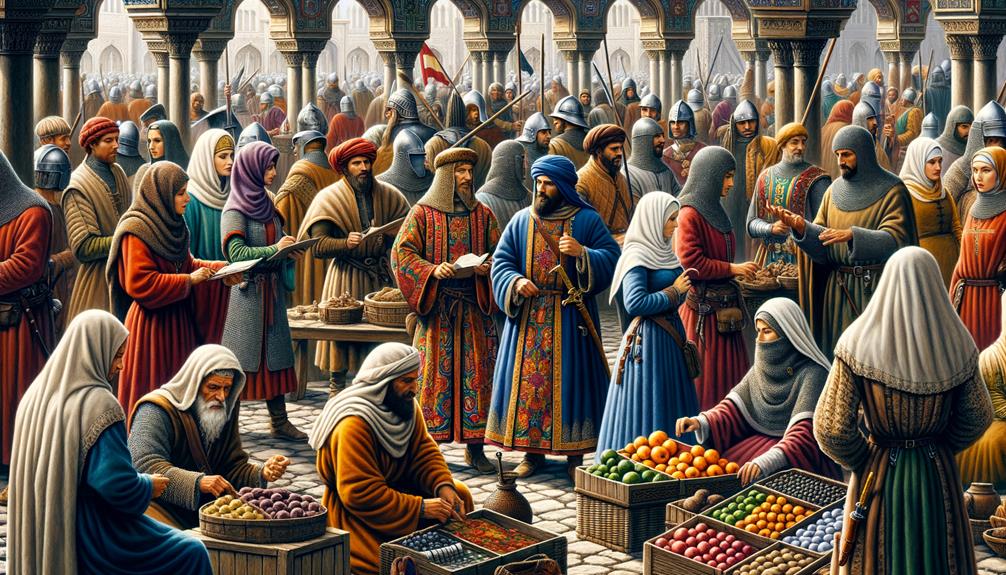
In the midst of medieval life, knights and nobles seamlessly integrate their armor into their daily routines, making each piece a reflection of their status and strength. The gleam of metal transforms into more than mere protection; it becomes a statement of functionality and fashion. Each meticulously crafted piece speaks of a world where utility and artistry intertwine.
As dawn breaks, I watch a knight don his armor, its appearance nothing short of majestic. The intricate designs etched into the steel whisper tales of valor and lineage, of battles fought and honor upheld. The care taken in maintaining each piece reveals a devotion to both the craft and the life it protects. It's more than just attire; it's an identity, a proclamation of one's place in the hierarchy of medieval society.
The fusion of armor with daily wear creates a unique tapestry where every clang of metal echoes the pulse of life. In every polished surface, I see a story, a reflection of a world where strength and elegance walk hand in hand.
Influence on Modern Fashion
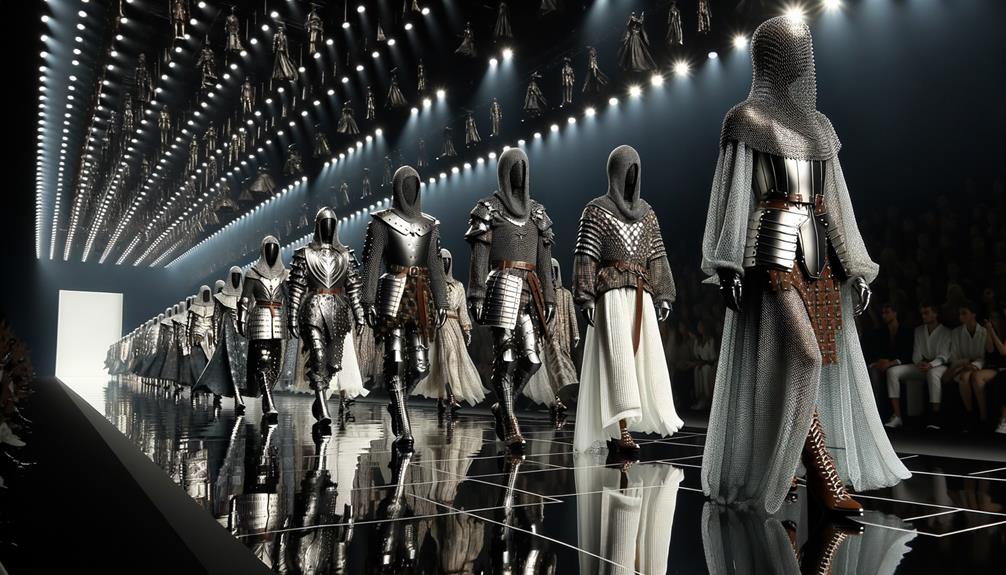
Here's a rewritten version of the text, following the provided guidelines:
When I take in today's runway shows, I'm struck by the echoes of medieval armor in modern fashion. The use of plated textures and metallic finishes is a clear nod to a time when protection was paramount, but now it's been reborn with a darker, edgier flair. Designers are incorporating these ancient influences into their designs, blending historical craftsmanship with modern aesthetics to create something entirely new.
Let me know if this meets your requirements!
Runway Trends Inspired
While browsing the latest runway shows, I've noticed how medieval armor's influence has seamlessly woven its way into modern fashion trends. The interplay of armor and fashion is more than just a nod to history; it's a striking blend of metal embellishments, chain mail structures, and etched ornaments that redefine contemporary elegance.
Today's designers draw inspiration from medieval armor to create surface patterns that mimic the rich textures of costly silk fabrics interspersed with intricate decorations. This fusion of steel armor and textiles manifests in elaborate and embellished designs that mesmerize.
| Medieval Armor | Modern Fashion | Elements |
|---|---|---|
| Metal Embellishments | Chain Mail Structures | Etched Ornaments |
| Surface Patterns | Rich Textures | Intricate Decorations |
| Diadems & Plumes | Accessories | Trappings |
As I observe, I see armor-inspired fashion accessories, such as diadems, plumes, and trappings, adding a regal touch to modern collections. The etching techniques once used to decorate medieval armor now influence contemporary designs with intricate patterns and detailing. This innovative blend of past and present fosters a fascinating and timeless aesthetic, inviting us to appreciate the grandeur of history in our daily lives.
Gothic Revival Elements
As I reflect on the ornate beauty of armor-inspired fashion, the Gothic Revival elements, with their angular lines and ribbed decorations, cast a captivating spell on modern silhouettes. The allure of medieval armor has woven itself into the fabric of contemporary civilian attire, creating a fascinating interplay between past and present. High collars and structured shapes evoke the regal stance of knights, while intricate lacework and dramatic silhouettes bring forth a dark, romantic essence.
Metal hardware, reminiscent of chainmail, adorns today's garments with a touch of medieval mystique. Designers seamlessly integrate these elements, transforming everyday wear into statements of strength and elegance. Leather accents and pointed arches add layers of texture and form, evoking the grandeur of Gothic Revival architecture. The ribbed decorations, akin to those that once shielded warriors, now sculpt the bodies of modern wearers, offering both protection and style.
In this fusion of eras, the contemporary civilian is not merely adorned but armored, ready to face the world with a blend of historical reverence and forward-thinking innovation. The Gothic Revival trend is a testament to the timeless allure of medieval armor, reimagined for the modern age.
Functional Aesthetics Adopted
The fusion of medieval armor's functional aesthetics into modern fashion fascinates me, as it combines practicality with enduring elegance. The 15th-century armor was designed to provide both protection and beauty, a concept that resonates deeply with today's designers. The fluted metal surfaces and etched decorations that were integral to medieval armor now inspire avant-garde fashion, blending historical craftsmanship with modern innovation.
Consider how textiles and metals were fused in armor construction. This historical blueprint offers a symbiosis of steel and fabric, which can inform contemporary designs that emphasize both durability and style. Decorative techniques, such as etched ornaments and surface patterns mimicking luxurious fabrics, have endured through time to influence today's fashion accessories and embellishments.
| Influential Element | Modern Application |
|---|---|
| Fluted Metal Surfaces | Structured, Geometric Lines |
| Etched Decorations | Intricate Accessories |
| Textile-Metal Fusion | Functional Yet Elegant Wear |
In observing these elements, I see how the past informs the present. The intricate, decorative elements of medieval armor remain a timeless source of inspiration. They serve as a testament to the enduring appeal of functional aesthetics, shaping fashion in ways that honor tradition while pushing the boundaries of contemporary design.
Frequently Asked Questions
What Clothing Was Worn Over Medieval Armor?
About 90% of knights wore surcoats over their armor, which I find fascinating. These flowing garments, belted just right, served both practical and symbolic purposes, offering a unique flair to a knight's identity and protection.
What Armour Did They Wear in Medieval Times?
I'm fascinated by the medieval warriors' intricate armor, comprising layered mail shirts, surcoats, and gauntlets. Regional variations showcase their resourcefulness, from France's ailettes to diverse arm and leg protections, leaving a legacy of innovation and resilience.
What Was the Purpose of Medieval Armor?
I've often wondered about the purpose of medieval armor. It wasn't just about protection; it was a testament to the craftsmen's skill, a display of power and status, a intricate blend of metal and fabric that both concealed and revealed.
What Clothing Did Medieval Knights Wear?
Reflecting on a knight's attire, I imagine layers of mail shirts, surcoats, and gauntlets. Helmets, reminiscent of Arthurian legends, adorned their heads. Each piece, intricately detailed, wove history and identity into the fabric of their being.



